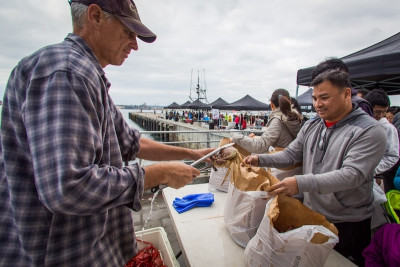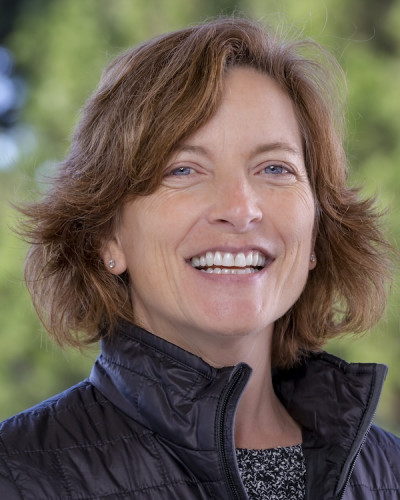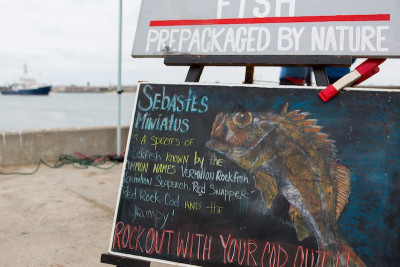California offers a plethora of seafood. But ironically the state’s abundant catch can make it particularly challenging to find reliable information about seafood sustainability, health and safety.
"There are data for nationally popular seafood like tuna, shrimp and salmon, but here in California, we have many species beyond that. In San Diego alone, we land over 100 different types each year, including rock crab, box crab, sea urchin, black cod and multiple rockfish species," says Theresa Talley, a coastal specialist with California Sea Grant.

A new interdisciplinary center at the University of California, San Diego, which includes experts from California Sea Grant, now aims to close the gaps in knowledge by exploring how nutrients such as selenium or omega-3 fatty acids and contaminants like methylmercury and PCBs (polychlorinated biphenyls) move through Pacific Ocean organisms and food webs.
The new Scripps Center for Oceans and Human Health, funded by $7.35 million from the National Institutes of Health (NIH) and the National Science Foundation (NSF), is a re-launch of an earlier effort under the same name. It will be one of four national facilities focused on better understanding the linkages between climate change, oceans and human health.
The collaborative center combines experts in marine chemistry, oceanography, pharmacology, molecular biology, marine biology, ecology, fisheries and conservation from UC San Diego, California Sea Grant and NOAA Fisheries’ Southwest Fisheries Science Center.
“We’ve come together to better grasp how contaminants in the oceans form and accumulate in ocean organisms, and how these interactions are impacted by climate change,” says Talley. "As a society, we need more research on how these substances interact and move,” including those that may land on people’s dinner plates.
Community engagement is an important part of the project. "We'll integrate the center's scientific discoveries and other information surrounding seafood diversity, sustainability and safety to fulfill the information needs of our community,” says Talley who co-leads this effort with Sarah Mesnick, an ecologist at the Southwest Fisheries Science Center. “We envision a range of needs, from chefs wanting information on local seafood availability, safe seafood handling and cooking tips, to agency staff wanting briefings of the latest science to inform their policies.” Specific activities could include informative websites, public seafood education events, science-to-policy panels and partnerships with local fishing communities.
To guide their work, Talley and Mesnick aim to form a community advisory group comprising representatives from state agencies, environmental and education nonprofits, community groups and the local food system. "We'll collaborate to identify what information the community needs," explains Mesnick, "and determine how to effectively communicate the information to this diversity of end-users.”

On the research front, the center will focus on three key areas of study.
The first project, co-led by Scripps marine biologist Amro Hamdoun and Geoffrey Chang, professor at the Skaggs School of Pharmacy and Pharmaceutical Sciences at UC San Diego, will investigate how pollutants such as toxic heavy metals accumulate in marine organisms. By zeroing in on the molecular level, the team aims to understand how some contaminants reach concentrations in seafood that could potentially harm human consumers.
A second study will explore how certain marine organisms such as sea sponges manufacture organic compounds that are basically identical to synthetic chemicals such as polybrominated diphenyl ethers (PBDEs), which are often used as flame retardants but can act as pollutants.
The scientists hope to uncover why sponges create these PBDEs, how their microbiomes help produce them, and how these toxins disperse within the fishes and organisms of the marine food webs. The project will be headed by Bradley Moore, who also serves as the center’s director and is a professor of marine chemistry at Scripps Oceanography and Skaggs School of Pharmacy and Pharmaceutical Sciences, and Eric Allen, a professor of marine biology and molecular biology with a joint appointment between Scripps and the School of Biological Sciences at UC San Diego.
How will climate change affect pollutants and micronutrients? This will be the focal point of a third project under the direction of Scripps Oceanography marine biogeochemist Amina Schartup and biological oceanographer Anela Choy. As oceans warm, marine species shift habitats, which can restructure food webs and alter how pollutants move through them. For instance, research has shown that methylmercury, a toxic heavy metal, is more prevalent at certain depths. If organisms move to or from those depths, it could impact how much methylmercury enters food chains that lead to popular seafood such as tuna and swordfish.
Schartup and Choy will develop models that simulate how climate change may affect the movement of interacting micronutrients, such as selenium and omega-3, and contaminants, such as methylmercury and PCBs, industrial pollutants once used as coolants.

The new center continues the work of the previous Scripps Center for Oceans and Human Health, which operated from 2013 to 2018 with grant funding from NIH and NSF. “There’s a lot of need for information about seafood, especially for the species caught in California or southern California, because they're not always mainstream,” says Mesnick.
“Much evidence suggests that the health benefits of seafood can far outweigh any risks,” Talley says. "Our goal is to provide balanced, science-based information to help the public make informed decisions about safely enjoying fish and other seafood."
About California Sea Grant
NOAA’s California Sea Grant College Program funds marine research, education and outreach throughout California. Headquartered at Scripps Institution of Oceanography at the University of California San Diego, California Sea Grant is one of 34 Sea Grant programs in the National Oceanic and Atmospheric Administration (NOAA), U.S. Department of Commerce.